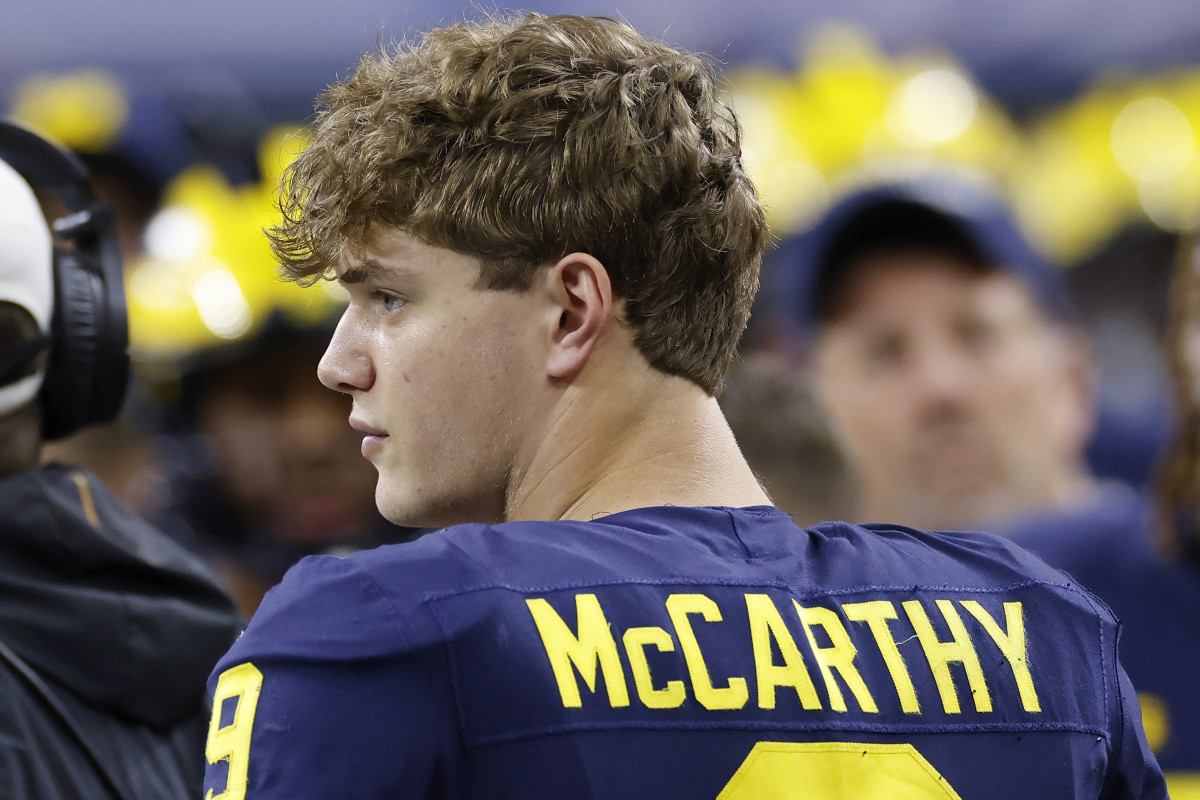JJ McCarthy’s Surgical History: Jj Mccarthy Surgery

JJ McCarthy, the talented quarterback for the University of Michigan Wolverines, has a history of surgical procedures that have shaped his athletic journey. While these surgeries have undoubtedly impacted his performance, they have also demonstrated his resilience and determination to excel on the field. Understanding the details of these surgeries, their potential implications, and the recovery process provides valuable insights into McCarthy’s path to success.
Timeline of JJ McCarthy’s Surgeries
This section details the known surgical procedures that JJ McCarthy has undergone, providing dates, types of surgeries, and reasons for the procedures.
- Date: Unknown, Type: Appendectomy, Reason: Removal of an inflamed appendix.
- Date: Unknown, Type: Shoulder Surgery, Reason: Repaired a torn labrum in his throwing shoulder. This surgery is common among athletes, particularly those who engage in overhead throwing motions.
Impact of Surgeries on McCarthy’s Athletic Performance
This section explores the short-term and long-term effects of McCarthy’s surgeries on his athletic performance.
- Short-Term Impact: An appendectomy can lead to a short period of recovery, impacting training and game participation. The recovery from shoulder surgery, particularly a labrum tear repair, can be more extensive, potentially requiring several months for full recovery and return to athletic activity.
- Long-Term Impact: While a successful appendectomy typically has no long-term impact on athletic performance, shoulder surgery can affect an athlete’s throwing mechanics and stability. However, with proper rehabilitation, athletes can often regain full strength and range of motion in their shoulder, allowing them to return to their previous level of performance.
Potential Risks and Complications Associated with McCarthy’s Surgeries
This section discusses the potential risks and complications associated with the types of surgeries McCarthy has undergone.
- Appendectomy: While generally considered a safe procedure, complications can occur, such as infection, bleeding, or damage to surrounding organs.
- Shoulder Surgery: Shoulder surgery, particularly for a labrum tear repair, can carry risks, including infection, nerve damage, stiffness, and instability.
Recovery Process and Rehabilitation Strategies for Athletes Who Have Undergone Similar Surgeries
This section explores the recovery process and rehabilitation strategies for athletes who have undergone similar surgeries, drawing on insights from medical professionals.
- Appendectomy: Recovery from an appendectomy typically involves a few days of hospitalization followed by a week or two of rest and light activity. Physical therapy may be recommended to help regain strength and flexibility.
- Shoulder Surgery: Recovery from shoulder surgery, particularly for a labrum tear repair, can be more extensive, requiring several months for full recovery. The rehabilitation process typically involves a gradual progression of exercises, starting with passive range of motion and progressing to strengthening and functional exercises. Physical therapy plays a crucial role in restoring strength, flexibility, and stability to the shoulder joint.
Common Surgeries for Athletes

Athletes, particularly in high-impact sports like football, are susceptible to various injuries that may require surgical intervention. Understanding the common surgeries, their procedures, benefits, drawbacks, and recovery timelines is crucial for athletes, coaches, and medical professionals involved in their care.
ACL Reconstruction
ACL reconstruction is a common surgery for athletes who suffer a tear of the anterior cruciate ligament (ACL), a key ligament in the knee that provides stability. This procedure involves replacing the torn ACL with a graft taken from another part of the body, such as the patellar tendon, hamstring tendon, or a cadaver. The graft is then secured to the femur and tibia bones using screws or other fixation devices.
ACL reconstruction is a complex procedure with a significant recovery period. It aims to restore knee stability and function, allowing athletes to return to their sport. However, it comes with potential risks, including infection, graft failure, and prolonged recovery.
The recovery process typically involves a period of immobilization followed by a gradual rehabilitation program focusing on strengthening, flexibility, and regaining range of motion. The rehabilitation program is tailored to the individual athlete and their sport, and it can take several months for athletes to return to full activity.
Shoulder Rotator Cuff Repair
The rotator cuff is a group of four muscles and their tendons that surround the shoulder joint. A tear in one or more of these tendons can lead to pain, weakness, and instability. Shoulder rotator cuff repair surgery aims to repair the torn tendon, restoring the integrity of the rotator cuff.
The procedure involves surgically accessing the torn tendon and repairing it using sutures or other fixation devices. The recovery process involves immobilization, physical therapy, and gradual return to activity. The recovery time can vary depending on the severity of the tear and the individual athlete’s condition.
Meniscus Repair and Replacement
The meniscus is a C-shaped piece of cartilage that acts as a shock absorber in the knee joint. A tear in the meniscus can cause pain, swelling, and instability. Meniscus repair surgery aims to repair the torn meniscus, while meniscus replacement surgery involves replacing the damaged portion of the meniscus with a synthetic or allograft material.
The recovery process for meniscus repair involves a period of immobilization followed by physical therapy. Meniscus replacement surgery often involves a shorter recovery period but may have a higher risk of complications.
Hamstring Repair, Jj mccarthy surgery
Hamstring injuries are common in athletes, particularly those involved in sprinting and jumping. These injuries can range from mild strains to complete tears. Hamstring repair surgery involves surgically repairing the torn hamstring tendon, restoring its function.
The recovery process involves immobilization, physical therapy, and a gradual return to activity. The recovery time can vary depending on the severity of the injury and the individual athlete’s condition.
Foot and Ankle Surgery
Athletes are susceptible to various foot and ankle injuries, including sprains, fractures, and tendon injuries. Surgery may be necessary for severe injuries, aiming to restore stability, alignment, and function.
Foot and ankle surgeries can involve procedures like ligament repair, tendon repair, fracture fixation, and joint fusion. The recovery process involves immobilization, physical therapy, and a gradual return to activity.
Other Common Surgeries
In addition to these common surgeries, athletes may require other surgical interventions for injuries involving the elbow, wrist, hip, or spine. The specific procedures and recovery timelines vary depending on the injury and the individual athlete’s needs.
The Role of Surgery in Sports Performance

Surgery can play a crucial role in an athlete’s journey back to competition after an injury. It can be a vital step in repairing damaged tissues and restoring function, but it’s not a guarantee of a smooth and successful return to play.
Factors Contributing to Successful Recovery and Return to Play
Successful recovery after sports surgery depends on a combination of factors, including:
- The nature and severity of the injury: Some injuries require more complex surgeries and longer recovery times than others.
- The athlete’s age, fitness level, and overall health: Younger, fitter athletes tend to recover faster and with fewer complications.
- The quality of surgical care: Skilled surgeons and experienced medical teams are essential for optimal outcomes.
- Adherence to the rehabilitation program: Consistent and dedicated participation in physical therapy and rehabilitation exercises is crucial for regaining strength, flexibility, and function.
- Psychological factors: The athlete’s mental state, motivation, and commitment to the recovery process can significantly impact the outcome.
The Psychological and Emotional Impacts of Surgery
Surgery can have a significant psychological and emotional impact on athletes.
- Fear and anxiety: The prospect of surgery and the uncertainty of recovery can be daunting for athletes.
- Loss of identity and purpose: Sports can be a defining aspect of an athlete’s life, and the inability to compete can lead to feelings of loss and frustration.
- Depression and mood swings: The physical and emotional challenges of recovery can contribute to mood changes and depression.
- Motivation and commitment: Maintaining motivation and commitment to the rehabilitation process can be challenging, especially during long and arduous recoveries.
Stages of Recovery and Key Milestones for Common Sports Surgeries
| Stage | Key Milestones |
|---|---|
| Immediate Post-Operative Stage (0-2 weeks) | Pain management, wound care, immobilization, limited range of motion exercises |
| Early Rehabilitation Stage (2-6 weeks) | Gradual increase in range of motion, controlled weight-bearing, strengthening exercises |
| Intermediate Rehabilitation Stage (6-12 weeks) | Increased weight-bearing, proprioception training, functional exercises, sport-specific drills |
| Late Rehabilitation Stage (12 weeks+) | Return to full activity, progressive loading, maintenance of strength and conditioning |
Jj mccarthy surgery – JJ McCarthy’s recent surgery has raised concerns about his availability for the upcoming season, prompting fans to analyze the Vikings’ depth chart at the quarterback position. To get a better understanding of the team’s options, check out the vikings depth chart and see how the team will manage if McCarthy is sidelined for an extended period.
The Vikings’ performance this season will depend heavily on their ability to fill the void left by McCarthy’s potential absence.
JJ McCarthy’s surgery, while not publicly disclosed, could potentially involve a torn meniscus, a common injury among athletes. Recovery from a torn meniscus can vary depending on the severity, with some requiring surgery while others can manage with conservative treatment.
For a comprehensive guide on torn meniscus recovery, including information on treatment options and rehabilitation, visit this website. Regardless of the specific procedure, McCarthy’s return to the field will depend on the successful healing of the affected area.
